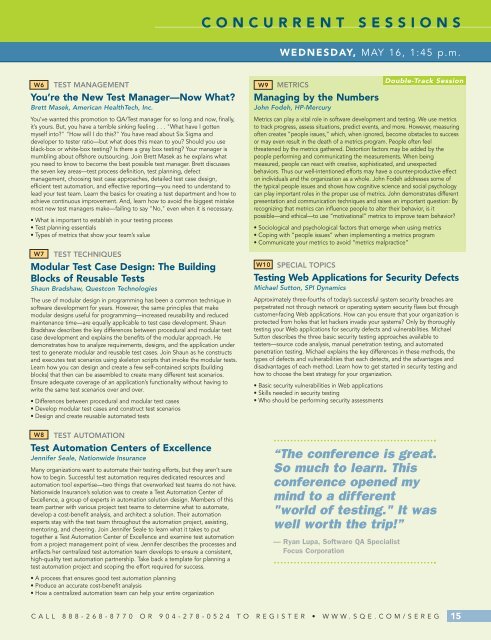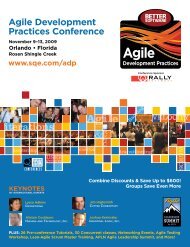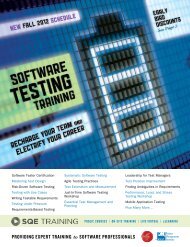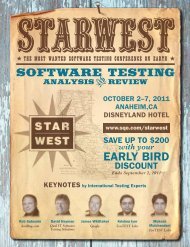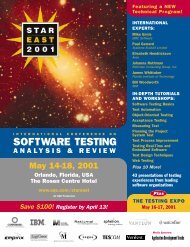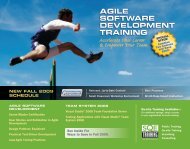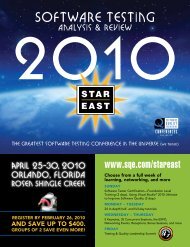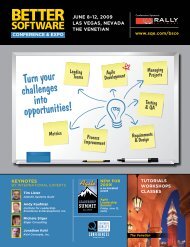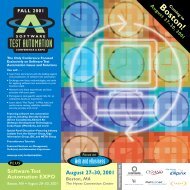SOFTWARE TESTING ANALYSIS & REVIEW - SQE.com
SOFTWARE TESTING ANALYSIS & REVIEW - SQE.com
SOFTWARE TESTING ANALYSIS & REVIEW - SQE.com
You also want an ePaper? Increase the reach of your titles
YUMPU automatically turns print PDFs into web optimized ePapers that Google loves.
CONCURRENT SESSIONSMONDAY, MAY 16, 8:30-5:00WEDNESDAY, MAY 16, 1:45 p.m.W6TEST MANAGEMENTYou’re the New Test Manager—Now What?Brett Masek, American HealthTech, Inc.You’ve wanted this promotion to QA/Test manager for so long and now, finally,it’s yours. But, you have a terrible sinking feeling . . . "What have I gottenmyself into?" "How will I do this?" You have read about Six Sigma anddeveloper to tester ratio—but what does this mean to you? Should you useblack-box or white-box testing? Is there a gray box testing? Your manager ismumbling about offshore outsourcing. Join Brett Masek as he explains whatyou need to know to be<strong>com</strong>e the best possible test manager. Brett discussesthe seven key areas—test process definition, test planning, defectmanagement, choosing test case approaches, detailed test case design,efficient test automation, and effective reporting—you need to understand tolead your test team. Learn the basics for creating a test department and how toachieve continuous improvement. And, learn how to avoid the biggest mistakemost new test managers make—failing to say "No," even when it is necessary.• What is important to establish in your testing process• Test planning essentials• Types of metrics that show your team’s valueW7TEST TECHNIQUESModular Test Case Design: The BuildingBlocks of Reusable TestsShaun Bradshaw, Questcon TechnologiesThe use of modular design in programming has been a <strong>com</strong>mon technique insoftware development for years. However, the same principles that makemodular designs useful for programming—increased reusability and reducedmaintenance time—are equally applicable to test case development. ShaunBradshaw describes the key differences between procedural and modular testcase development and explains the benefits of the modular approach. Hedemonstrates how to analyze requirements, designs, and the application undertest to generate modular and reusable test cases. Join Shaun as he constructsand executes test scenarios using skeleton scripts that invoke the modular tests.Learn how you can design and create a few self-contained scripts (buildingblocks) that then can be assembled to create many different test scenarios.Ensure adequate coverage of an application’s functionality without having towrite the same test scenarios over and over.• Differences between procedural and modular test cases• Develop modular test cases and construct test scenarios• Design and create reusable automated testsW8TEST AUTOMATIONTest Automation Centers of ExcellenceJennifer Seale, Nationwide InsuranceMany organizations want to automate their testing efforts, but they aren’t surehow to begin. Successful test automation requires dedicated resources andautomation tool expertise—two things that overworked test teams do not have.Nationwide Insurance’s solution was to create a Test Automation Center ofExcellence, a group of experts in automation solution design. Members of thisteam partner with various project test teams to determine what to automate,develop a cost-benefit analysis, and architect a solution. Their automationexperts stay with the test team throughout the automation project, assisting,mentoring, and cheering. Join Jennifer Seale to learn what it takes to puttogether a Test Automation Center of Excellence and examine test automationfrom a project management point of view. Jennifer describes the processes andartifacts her centralized test automation team develops to ensure a consistent,high-quality test automation partnership. Take back a template for planning atest automation project and scoping the effort required for success.• A process that ensures good test automation planning• Produce an accurate cost-benefit analysis• How a centralized automation team can help your entire organizationW9METRICSManaging by the NumbersJohn Fodeh, HP-MercuryDouble-Track SessionMetrics can play a vital role in software development and testing. We use metricsto track progress, assess situations, predict events, and more. However, measuringoften creates “people issues,” which, when ignored, be<strong>com</strong>e obstacles to successor may even result in the death of a metrics program. People often feelthreatened by the metrics gathered. Distortion factors may be added by thepeople performing and <strong>com</strong>municating the measurements. When beingmeasured, people can react with creative, sophisticated, and unexpectedbehaviors. Thus our well-intentioned efforts may have a counter-productive effecton individuals and the organization as a whole. John Fodeh addresses some ofthe typical people issues and shows how cognitive science and social psychologycan play important roles in the proper use of metrics. John demonstrates differentpresentation and <strong>com</strong>munication techniques and raises an important question: Byrecognizing that metrics can influence people to alter their behavior, is itpossible—and ethical—to use “motivational” metrics to improve team behavior?• Sociological and psychological factors that emerge when using metrics• Coping with “people issues” when implementing a metrics program• Communicate your metrics to avoid “metrics malpractice”W10SPECIAL TOPICSTesting Web Applications for Security DefectsMichael Sutton, SPI DynamicsApproximately three-fourths of today’s successful system security breaches areperpetrated not through network or operating system security flaws but throughcustomer-facing Web applications. How can you ensure that your organization isprotected from holes that let hackers invade your systems? Only by thoroughlytesting your Web applications for security defects and vulnerabilities. MichaelSutton describes the three basic security testing approaches available totesters—source code analysis, manual penetration testing, and automatedpenetration testing. Michael explains the key differences in these methods, thetypes of defects and vulnerabilities that each detects, and the advantages anddisadvantages of each method. Learn how to get started in security testing andhow to choose the best strategy for your organization.• Basic security vulnerabilities in Web applications• Skills needed in security testing• Who should be performing security assessments“The conference is great.So much to learn. Thisconference opened mymind to a different"world of testing." It waswell worth the trip!”— Ryan Lupa, Software QA SpecialistFocus CorporationCALL 888-268-8770 OR 904-278-0524 TO REGISTER • WWW.<strong>SQE</strong>.COM/SEREG 15


